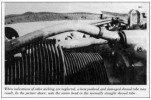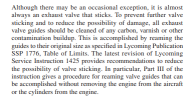What is usually called “sticking” should be called “hanging.” It is not because of tight guides. It is caused by worn completely out guides and stems. They get so worn out that they cock sideways so far that they hang on the edge of the seat, and the inner, flat edge of the valve among the taper.
Growing up in my Dad and uncles auto repair business in the days of valve jobs and in frame overhauls, I’m not a neophyte when it comes to piston engines. I ground more valves, seats and knurled more guides than I can remember. When learning to fly in 1992, there was a rental 150 that the guys would say the valves were “sticking.” I could never really envision guides and stems in the process of wearing, getting tight enough to “stick.” A couple of years ago, a friends RV he had recently bought, had some super low compressions and we pulled cylinders and investigated. That’s the first time that I ever saw such a radical amount of guide/valve wear. It was indeed so bad that a valve was cocking sideways and hanging.
As far as Lycomings not making metal initiated by corroded lifters, tell that to the very long list of those people who bought a low or mid time Lycoming that had not been started for a lengthy amount of time. The cam is high where oil can drip off and maybe they have different alloy lifters, but it is VERY common for a Lycoming that has been put back in service after lengthy storage to make metal after a period of time. What happens is that the corrosion, however minor, on the face of the lifter makes microscopic pits. as the cam wipes across the lifter, it peels tiny pieces of metal out off of the lifter face. it is much like a pothole. Every time a car drives over a pothole it peels a rock out of the pothole. After a period of time the small hole turns into a large pothole. as that metal breaks out, it circulates and makes even more metal. I have a number of these lifters in my shop. I will try to remember to post a picture. Believe me! This is a common problem. To make it worse, the case must be split to change the Lycoming lifters. If they were barrel lifters that could be changed without splitting the case, changing them before putting the engine back in service, would be a process very worthwhile.
Lycoming now has lifters called “Diamond Like Coating(DLC) that prevent the corrosion problem and in the long run will save many lycomings that come out of storage. I bought a plane that had sat up for several years, but cylinders were pulled, lifters inspected and given a green light. About a year later, I got to be the one to pay for the overhaul. This was a 900 hour since new engine. The DLC lifters were very hard to get at the time, but fortunately I got a set before it went back together.
Don’t EVER believe that nothing can deteriorate in an engine because it was stored for an extended period. You might get lucky, because I’m sure that some come out okay, but it’s a big risk. Approach an airplane for sale after extended storage with a healthy checkbook. Been there! Done that!



